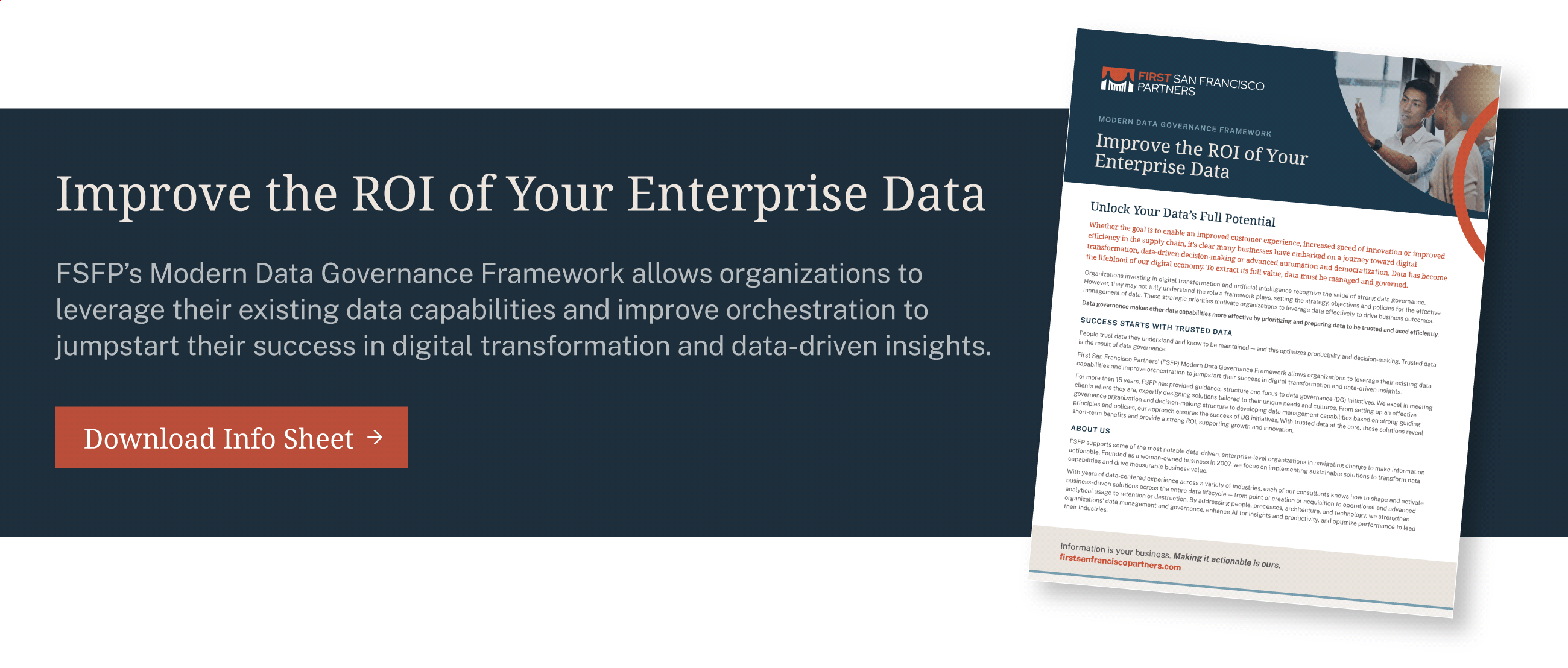After moving between companies as a financial analyst, I decided a career switch was in my best interest. I needed to find something engaging to leverage my previous experience, the good and the bad. Through a friend and soon-to-be colleague, I found First San Francisco Partners (FSFP) and data governance.
Before my career in data governance, I was a numbers guy. I’d worked in the financial space, building models (a guilty pleasure of mine), churning reports and creating a story behind the numbers. This, of course, is paramount in understanding the ebbs and flows of a business. Sometimes the creation of that story can be a hard-fought battle, and, as analysts, many of us run into the same dilemmas every day without realizing there’s a fix. What do the numbers tell me, and how do I know? Are we sure this is accurate? What’s the source of this? Which report do I run again?
If you’ve ever asked these questions, please know two things: I feel your pain, and there’s a solution.
Lesson 1: You’re probably doing governance without realizing it
In my past roles as an analyst, I would go to an enterprise resource plan and click through a maze of reports (most of which remained untouched since their creation) until I landed on what I needed. I selected the date range and any other pertinent querying information, and voila – the numbers appeared before my very eyes.
From there, I used my methods of validating the numbers to ensure I could provide quality insight from my work. A “controls” tab in my Excel model showed the date range of the report, the name of the report I ran, variable inputs and how I calculated KPIs. I would list other reports that arrived at this same number for proof and meticulously record my every move throughout the process in case questions came forth about the details.
Unbeknownst to me at the time, I had assembled a handful of governance practices that had a direct parallel in the data realm. I created a glossary to define the jargon often used in our reporting. I defined and validated KPIs to lower ambiguity and allow lineage to other reports. I worked with others to create workflows showing the start-to-finish process of reporting cycles.
Many of us do these things in various roles without realizing the criticality of formalizing the practice of data governance.

FSFP’s Dave McDermott
Lesson 2: Connect and immerse yourself in opportunities
I met my friend (and FSFP teammate) Marcus Gruel for a happy hour in the fall of 2021. We caught up and exchanged stories for a few hours over a drink and meal. Throughout that evening, I realized Marcus had a consulting career where he was professionally engaged in many of the governance activities I currently did just to make my life easier.
Upon recognizing this, my ears immediately perked up with interest. I asked question after question to better understand what it means to be a data governance consultant. Marcus’ role sounded fascinating. I had no idea there was a career built on establishing governance for a business.
The conversation consumed me for days until Marcus reached out and said he’d be happy to submit my resume. Before I knew it, I was interviewing for FSFP and excited about the prospect of working here.
A couple of things I quickly learned about FSFP: This company cares about their employees and provides them with all the benefits and support they could ask for — and the people at the company are amongst some of the brightest minds I’ve encountered!
This job is exactly what I was looking for in a career. It’s challenging, requires high adaptability and opens you up to the foremost thought-leaders in the data space. A career in information technology was something I wished I had done out of college. To my elation, the job offer came through, and honestly, I knew what my answer would be from the second I heard about the company.
Lesson 3: Leave your comfort zone at the door
Working at FSFP has been oh-so rewarding since I started. That isn’t to say it didn’t come with its unique challenges. As in every job and especially one where you switch industries, there’s a massive learning curve upfront. This can be intensified by client expectations, tight deadlines and overall eagerness to prove one’s worth.
Throughout my first client engagement, I’ve been given a variety of projects from which I could draw on minimal prior experience. It can be stressful as you begin working through the unknowns of a new deliverable while mostly unsure you’re fit for the task at hand. I often reminded myself that this company believes in me, and I believe in me.
That said, one thing that mitigates this stress is my FSFP peers’ willingness to help each other with anything and everything. Here, it’s heavily encouraged to reach out for guidance when you encounter a roadblock. Everyone is patient and quick to help their coworkers or point them toward a resolution. It’s especially awesome for someone like me, who says yes to just about every ask.
It’s remarkable how much you can learn when redefining your professional comfort zone. I stayed willing to learn any new facet of the industry and wanted to figure out how it fits into an engagement. After all, there’s practically no way to learn something without rolling up your sleeves and doing it. I found this particularly relevant in the master data management and data quality spaces, which I’ve grown to enjoy. The concepts, jargon, acronyms and tools are so foreign when you first see them, but they begin to make sense after a while. And in my case, I enjoy working through the nuances of data quality and love drawing parallels to prior professional experiences.
At FSFP, it’s rewarding to take on assignments that are more unfamiliar to me and then watch everything come to fruition at the end. To sum it all up, I feel incredibly valued for completing my work for the client and our company.



